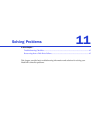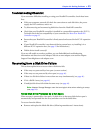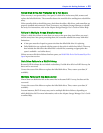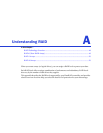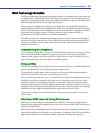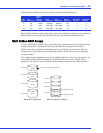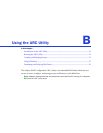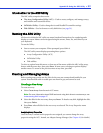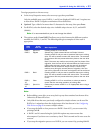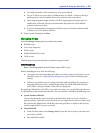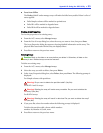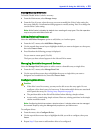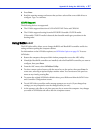
Appendix A: Understanding RAID ● 50
RAID 1 Arrays
A RAID 1 array is built from two disk drives, where one disk drive is a mirror of the other (the
same data is stored on each disk drive). Compared to independent disk drives, RAID 1 arrays
provide improved performance, with twice the read rate and an equal write rate of single disks.
However, capacity is only 50 percent of independent disk drives.
If the RAID 1 array is built from different-sized disk drives, the free space, drive segment size is
the size of the smaller disk drive, as shown in the following figure.
RAID 10 Arrays
A RAID 10 array is built from two or more equal-sized RAID 1 arrays. Adaptec RAID
controllers support a maximum number of 48 disk drives in a RAID 10 array.
Data in a RAID 10 array is both striped and mirrored. Mirroring provides data protection, and
striping improves performance.
Drive segment size is limited to the size of the smallest disk drive in the array. For instance, an
array with two 250 GB disk drives and two 400 GB disk drives can create two mirrored drive
segments of 250 GB, for a total of 500 GB for the array, as shown in the following figure.
Disk Drive 1
Disk Drive 2
250 GB
400 GB
Disk Drives in Lo
g
ical Drive
Disk Drive 1
Disk Drive 2
RAID 1 Lo
g
ical Drive = 250 GB
Not Used
Unused Space: 150 GB
1 – 250
1 – 250
Drive Segment Size (Smaller Disk Drive)
Disk Drive 1
Disk Drive 2
Disk Drive 3
Disk Drive 4
250 GB
250 GB
400 GB
400 GB
Disk Drives in Logical Drive
Disk Drive 1
Disk Drive 2
Disk Drive 3
Disk Drive 4
RAID 10 Lo
g
ical Drive = 500 GB
1
2
1
2
Not Used
Not Used
3
4
3
4
500
499
500
499
...
...
...
...
Unused Space: 150 GB
Unused Space: 150 GB
Drive Segment Size (Smallest Disk Drive)





